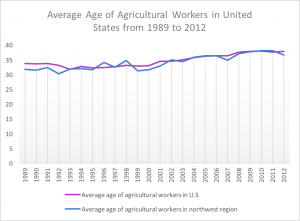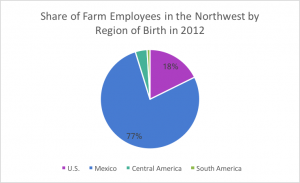Rural Mexico in Transition Out of Farm Work
In a recent article, Ed Taylor and I identify a negative trend in the farm labor supply from rural Mexico. We find that the probability that individuals from rural Mexico work in agriculture (whether in Mexico or the United States) is decreasing by 0.97 percentage points per year on average. That implies that over 150 thousand individuals from rural Mexico are leaving agriculture each year.
What is Causing the Downward Trend?
Several factors are pushing and pulling rural Mexicans out of farm work, including growth in non-farm employment in Mexico, decreasing birthrates, and rising education. Rising U.S. farm wages help retain individuals in the agricultural workforce, but they do not reverse the overall trend.
Access to education is also a critical component since it impacts the skills and preferences of the workforce for many generations. Many individuals from rural Mexico that entered the workforce in recent years were the first from their village that could attend a secondary school near their home. I find that individuals that were young enough to attend secondary school when a school was constructed in their village had more education and were substantially less likely to work in agriculture than individuals from the same village that were too old to attend the school. This means that as school supply continues to grow in rural Mexico, the farm labor supply will continue to shrink.
What Does this Mean for Farmers in the U.S. and Montana?
Growing demand for farm labor in the United States during the latter half of the twentieth century was consistently and reliably met by an elastic supply of workers from rural Mexico. In the future, agricultural employers can expect a smaller, more educated workforce. The farm workforce in the Northwest (Idaho, Montana, Wyoming, Colorado, Nevada, Utah, Oregon, and Washington) as well as the United States is aging (See Figure 1), and younger generations are not coming to replace these workers.
Figure 1. Aging Farm Workforce

Source: National Agricultural Workers Survey (NAWS). https://www.doleta.gov/agworker/naws.cfm
Mechanization and robotics can the reduce the demand for farm labor and increase labor productivity as the farm labor supply shifts inward. Farm wages are expected to rise as technologies increase workers’ productivity. Rural communities are expected to benefit as earnings and local spending rise.
In Montana, much of the agricultural production is already mechanized. Nevertheless, agricultural production in Montana and the Northwest still depends in part on a foreign-born workforce. Over one thousand workers employed in agriculture in Montana in 2015 (Montana Department of Labor and Industries). Figure 2 shows the share of hired farmworkers in the Northwest region by region of birth in 2012. The majority are from Mexico, which implies that the agricultural industry in the Northwest, as in other regions, will need to prepare for a more inelastic farm labor supply.
Figure 2. Farm Workforce by Country of Birth

Source: National Agricultural Workers Survey (NAWS). https://www.doleta.gov/agworker/naws.cfm
Note: Thanks to Thomas Gumbley for help with statistics and figures.

